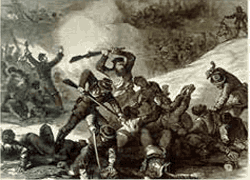 | |||||||||||||||||||||
|
In April, the Union garrison at Fort Pillow, a Confederate-built earthwork fortification and a Union-built inner redoubt, overlooking the Mississippi River about 40 river miles above Memphis, comprised 295 white troops of the 13th Tennessee Cavalry and 265 blacks troops of the 11th U.S. Colored Troops, all under the command of Maj. Lionel F. Booth. Tennessee was a Confederate state, and Union soldiers from Tennessee were considered to be traitors. The black soldiers, mostly freed slaves, were hated as much as the "renegade Tennesseans." Gen. Nathan B. Forrest, in a message to headquarters, said, "There is a Union force of 500 or 600 at Fort Pillow which I shall attend to... as they have horses and supplies which we need."
On April 12, at 4:30 A.M., 1,500 of Forrest's men assaulted the fort and quickly hemmed the garrison into their innermost earthwork. Forrest arrived at 10:00 A.M. and placed men in strategic positions where they could fire down on the garrison. Forrest seized the older outworks, with high knolls commanding the Union position, to surround Booth's force. Rugged terrain prevented the gunboat New Era from providing effective fire support for the Federals.
The garrison was unable to depress its artillery enough to cover the approaches to the fort Confederate sharpshooters, on the surrounding knolls, began firing into the fort killing Booth. Maj. William F. Bradford then took over command of the garrison. The Confederates launched a determined attack at 11:00 A.M., occupying more strategic locations around the fort.The men kept up a murderous fire until 3:30 P.M., when Forrest displayed a flag of truce and demanded the surrender of the fort. Maj. Lionel F. Booth, commander of the fort, had been killed by a sharpshooter earlier that morning. The second in command, Maj. William F. Bradford, requested an hour to consult with his subordinates. Bradford was expecting reinforcements to arrive on Mississippi transport boats before that time.
Forrest could see the smoke from vessels on the river and, suspecting Bradford's plan, gave him only 20 minutes to decide. At the end of that time, the surrender was refused, and Forrest ordered his men to take the fort. The Confederates renewed the attack, soon overran the fort, and drove the Federals down the river's bluff into a deadly crossfire where many tried to surrender.
The Confederates evacuated Fort Pillow that evening so they gained little from the attack except a temporary disruption of Union operations. The "Fort Pillow Massacre" became a Union rallying cry and cemented resolve to see the war through to its conclusion.
Some Federals claimed that as Confederates scaled the earthworks they screamed racial epithets and killed black troops who had thrown down their arms in surrender. Others said Forrest's men killed wounded blacks and whites where they lay. Confederates claimed the high Union casualty rate came when garrison survivors ran, fighting their way to the river. Some Confederates said blacks picked up arms again after having surrendered and suffered the consequences. other accounts attribute the high casualty rate among blacks to their tenacious defense at the earthworks, some Federals and Confederates saying they were the last to break and run for the rear. Only 58 of the 262 black troops engaged were taken prisoner. The black units suffered 64% killed; the white units only 33%. The Union public called it a massacre.
The U.S. Congress' Committee On The Conduct Of The War investigated, gathering blood-curdling testimony from some of the wounded left behind when forrest's troops evacuated Fort pillow the night of April 12. Response of the Confederate government was slow; Forrest's battle report, stalled in transit, was not brought to light until 4 months after the engagement. Forrest denied it was a massacre. Historical evidence remains divided between adherents of Union and Confederate views. There is general agreement that Confederates had extra animosity toward white members of the Union 13th Tennessee Cavalry, called "Tories, renegades, or homegrown Yankees". Racial antipathy toward black troops was well documented. It is probable, wether regarded as a massacre or not, Confederates hit Fort pillow defenders with more zeal than usually reserved for the enemy, and some excesses occured.
The "Fort Pillow Massacre" became a Union rallying cry and cemented resolve to see the war through to its conclusion. In the aftermath of this incident, Lincoln demanded that Confederates treat captured black Union soldiers as prisoners of war. This demand was refused, and as a result, the exchanges of prisoners that had gone on during the war were ended.
